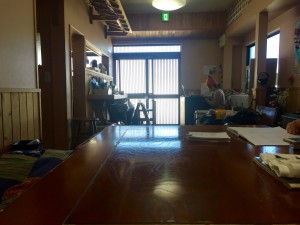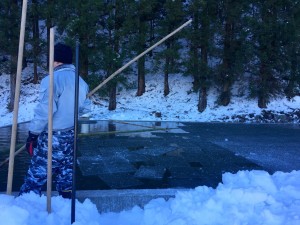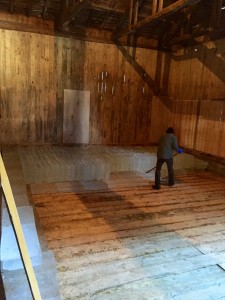This is a joint post, authored by Kate and B!
After arriving in Nikko intending to frolic through the wilderness for our free days, we checked into our hostel, Guesthouse Sumica (10/10, would recommend). After a short moment of confusion involving the workings of the front door — we are not yet completely accustomed to the ubiquity of sliding front doors — we were greeted by our friendly innkeepers. Before we could even hop under the kotatsu with our soon-to-be roommates from Portugal and Thailand, the innkeepers asked when we were leaving. Thinking that this was a normal thing for an innkeeper to ask, although an interesting choice for an introductory question, we replied that we had to be on the Shinkansen from Utsunomiya to Nasushiobara by 3:08 pm on Tuesday the 19th.
“Very good!” our innkeeper exclaimed. As it turns out, we had the most perfectly timed visit to Nikko. The details of an upcoming event were limited and quite unclear at this point, but the gist was that there was going to be an ice-harvesting event on the morning of the 19th and we were going. The innkeepers had already arranged to drive us to a non-specified location to observe the annual tradition and cheer on the ice cutters. So, on the 19th, we woke up, drank our yogurt and ate our dry pastries from 7/11 under the kotatsu while we waited for a ride to the mysteriou s event.
s event.
We were sipping green tea when the innkeeper’s wife frantically entered the guesthouse, apologizing for being late as a result of a traffic accident. She told us not to worry, though, because the accident was her fault, not the cars (obviously, we were still concerned). We, along with our Thai roommate, swallowed our fears, piled into her car, and took off towards the event, with directions to remember the route, as we were on our own to get back. After a couple twists, turns, and moments of panic before remembering it is correct to drive on the left side of the street, we came upon an ungroomed bridge with piles of snow and trails of ice. The car stopped. It became clear at this point that our innkeeper was not accompanying us to the ice event. Her parting words were “Walk up this road, when you see men swinging sticks above their heads, you know you are in the right place” and “Look for man with the hat. He is the boss. Tell him ‘yoroshiku onegai shimasu’ (rough translation: I look forward to sharing this experience with you/nice to meet you) and ‘gambatte kudasai’” (rough translation: please work hard/good luck).
After trekking up the winding snow and ice covered road, we happened upon a crowd of men, all of which were wearing hats. As we approached, we bowed saying ‘yoroshiku onegai shimasu’ and ‘gambatte kudasai’ to all of the hat-wearing men.  Standing on a platform overlooking the action, surrounded by men with large scythe-like tools, stood a burly man with a black, leather western-style hat embellished with alligator teeth (?). His outlandish hat, in combination with his emanating authority confirmed that we had found the boss. As instructed, we exchanged proper greetings, and then watched in awe as the men clawed large ice blocks out of the concrete retention pond, and slung them down a 50-foot long rickety chute, hand-made out of bamboo. One by one we were handed the scythe and invited to give the blocks a strong heave down the bamboo slide. After two attempts with the masters, we were told to try it by ourselves, likely for the comic relief of those who had been practicing this art for their entire lives. We each successfully propelled a couple blocks down the chute with cheers (and chuckles) from the small crowd.
Standing on a platform overlooking the action, surrounded by men with large scythe-like tools, stood a burly man with a black, leather western-style hat embellished with alligator teeth (?). His outlandish hat, in combination with his emanating authority confirmed that we had found the boss. As instructed, we exchanged proper greetings, and then watched in awe as the men clawed large ice blocks out of the concrete retention pond, and slung them down a 50-foot long rickety chute, hand-made out of bamboo. One by one we were handed the scythe and invited to give the blocks a strong heave down the bamboo slide. After two attempts with the masters, we were told to try it by ourselves, likely for the comic relief of those who had been practicing this art for their entire lives. We each successfully propelled a couple blocks down the chute with cheers (and chuckles) from the small crowd.
Finally, we were given the details of the event we were currently participating in. This was one of four family run, natural ice operations remaining in Japan. Shaved ice, also known as kakigori, is a delicacy throughout the country, but the majority of the ice consumed nationally is not sourced naturally, as it is in Nikko. The pool that this family harvested from was fed by mountain rivers, making it even more of a specialty. We were encouraged to take photos and tell our friends about our icy adventure, but were prohibited from  sharing “the GPS points” of the pond for fear that someone may want to “poison” the supply, rendering it unusable. As this was being explained to us, we noticed a loud buzzing noise coming from the sky. We looked up to see a small drone hovering above, recording video footage. We initially thought that this was the enemy attempting to uncover the state secret location of the pond; however, in reality, it was local news station covering the event. The boss informed us, through a proud smile, that today news stations from Nikko and the USA (apparently a personal friend of Steve Jobs, or so we interpreted from “friend of blah blah Jobs” and “iPhone”) and that tomorrow Australian reporters from Lonely Planet Magazine and the UK were coming to share the tradition with the world.
sharing “the GPS points” of the pond for fear that someone may want to “poison” the supply, rendering it unusable. As this was being explained to us, we noticed a loud buzzing noise coming from the sky. We looked up to see a small drone hovering above, recording video footage. We initially thought that this was the enemy attempting to uncover the state secret location of the pond; however, in reality, it was local news station covering the event. The boss informed us, through a proud smile, that today news stations from Nikko and the USA (apparently a personal friend of Steve Jobs, or so we interpreted from “friend of blah blah Jobs” and “iPhone”) and that tomorrow Australian reporters from Lonely Planet Magazine and the UK were coming to share the tradition with the world.
Then, we were escorted down to the storage facility. At the end of the chute stood a man who caught the blocks and diverted them into a large wooden building, where they were to be stored for the remainder of the year. The ice was stacked with wood shavings for insulation. They used to fill to building to the rafters and sometimes even to the roof with their typical three harvests of ice per year. However, due to the warming climate, they now have fewer harvesting events (just one or two a year) and are lucky if they can fill the building to the three-quarter mark. Despite insulation efforts, up to 80% of their ice was typically lost due to melting over the course of the year. Eventually, they decided to invest in a freezer and now retain the majority of their product.
During a pause in the action, in which they had to saw more blocks from the ice sheet, we were ushered into a small room with about ten elderly Japanese men circled around a wood stove. Through the thick smoke of unregulated Japanese cigarettes, we were told that the men in the room were owners of the cafes that sold the shaved ice during the warmer months. It was necessary for these owners be present for the event not only to contribute their brawn to the task, but also to ensure the quality and source of the product. Due to the popularity and value of shaved ice, these men had become quite famous and wealthy in Nikko. So there we sat, in a smoggy room, listening intently to the Japanese we could not understand, with the rich and famous of Nikko.
Believe it or not, on our journey back to the hostel, we discussed the ice-harvesting event in the context of our class (we did, we swear!). We found it interesting that it was absolutely necessary for the shaved ice vendors to be present at the event, relating to our class discussions of modern society’s alienation from food. The presence of the cafe owners was the embodiment of a deep connection to the source of the food. The labor and quality assurance lent by the cafe owners made them a crucial part of the harvest. As a result of their involvement through the entire process, a closed loop is formed, eliminating alienation from the source.
Our adventure also tied into concepts discussed in the Nagawa-machi workshop from a few days before. There we discussed how we have observed that Japan, as a whole, has a depth of shared tradition, culture, and history that America (or at least the upper Midwest) seems to lack. We observed this depth through traditional community events and food, including festivals lined with street vendors, mochi and mayudama making, and the dondo-yaki event. The ice-harvesting event we experienced was no exception. Despite the evolution and adaptation of the practice in response to modern societal, environmental, and technological changes, the tradition embedded in the practice and people continue to persist.

Recent Comments